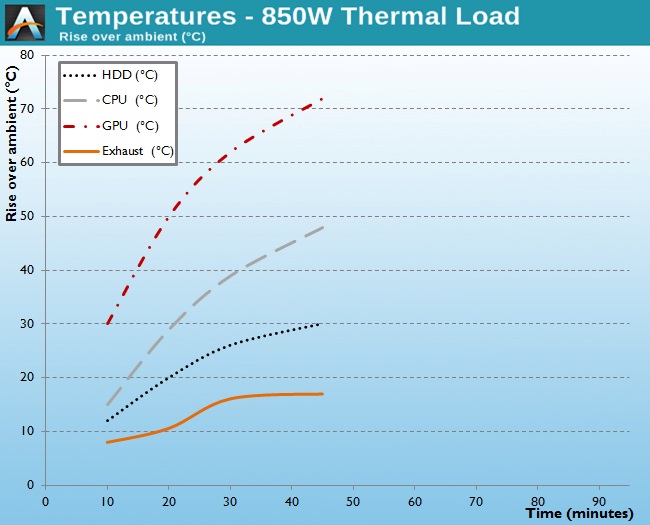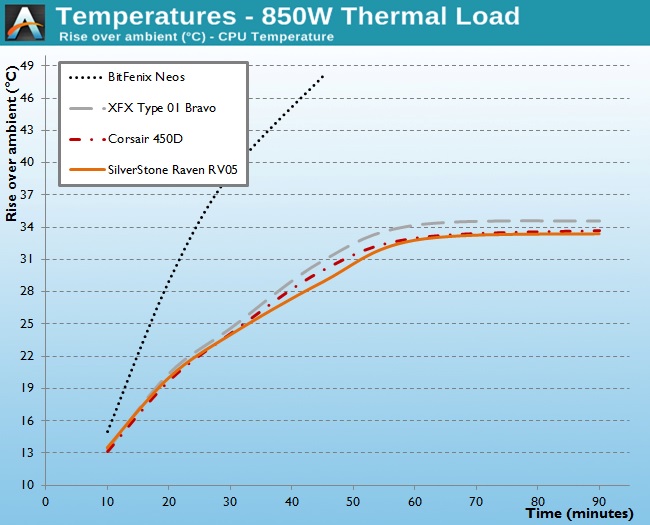BitFenix Neos Case Review
by E. Fylladitakis on January 21, 2015 9:00 AM EST- Posted in
- Cases/Cooling/PSUs
- bitfenix
- Case
Test Setup
Professional testing requires the emulation of real-world situations with repeatable results; thus, a perfectly controllable test setup and environment are required, especially for comparable results. Testing the thermal performance of any case with a typical real-world setup technically limits the comparability of the results to this setup alone, as an active system interacts with its environment and the change of a single component would alter myriads of variables.
To help alleviate such issues, we developed synthetic loads that emulate the thermal output of real systems, but these loads are passive, steady, and quantifiable. Our thermal testing now displays the thermal capabilities of the case alone, as if it would have to deal with the entire thermal load by itself, regardless of the system installed inside it. Laboratory data loggers are used to monitor the PT100 sensors and control the safety relays, which are fully accessible via our custom software.
Three such loads have been developed; the ATX version simulates a 200W CPU, 50W VRM, 30W RAM and 4 × 120W GPU card thermal load. Finally, three 3.5" HDD dummy loads have also been created, with each of them converting 30W of electrical power to thermal, bringing the total thermal load of the ATX test setup up to 850 Watts. This thermal load is immense and only the best of cases will be able to handle it for more than a few minutes; we are also performing a test with a thermal load of 400W, with all of the aforementioned components except the HDD drives at about 42% power, which is more suitable for the majority of cases.
Thermal testing is performed with the stock fan operating at maximum speed. Noise testing is performed with a background noise level of 30.4dB(A). Advanced noise testing is also performed, in order to assess the ability of the case to dampen the noise of the components installed inside it. This includes the installation of two noise-generating sources (strong fans) inside the case, one positioned approximately over the first expansion slot and one over the CPU area, which generate ≈ 44.2 dB(A) when unobstructed. During the advanced noise test, all stock cooling options of the case are entirely disabled.
Results and Discussion
Our testing ended prematurely when the thermal load was operating at full power, as the thermal failsafe kicked in. Sadly, the stock thermal performance of the Neos is, simply put, horrific. Despite the large openings at the front of the case and the presence of a strong 120mm exhaust fan, the Neos performed far worse than we originally anticipated. It handles the 400W load better, but it's definitely not the best case for high performance systems.
When compared to other cases of similar size, the enormous difference becomes apparent. Note that the thermal load used during our testing is immense; a typical home/gaming system with a single GPU should operate just fine in the Neos, yet the operating temperatures will be considerably higher than with a more advanced case.
There is just one 120mm cooling fan in the Neos, and it is a fairly strong and noisy model. The single 120mm fan generates 44.3dB(A), which is enough to be clearly audible to the user from one meter away. There are no fan control options for the Neos, therefore a fan controller is required to achieve the 50% and 70% fan speeds depicted in the chart below.
As expected, the Neos has very little noise reduction capabilities as well. It is simply not designed with low-noise operation in mind and there are virtually zero noise reduction measures about this case. The many openings at the front do not help either. The Neos reduced the noise level of our artificial noise source from 44.2dB(A) to 43.0dB(A), a very small and virtually imperceptible difference for the human ear.















54 Comments
View All Comments
Oxford Guy - Wednesday, January 21, 2015 - link
You can get a case for $25 that can be used for a low wattage system. Why spend so much on this? It doesn't have good cable management, etc.SleepModezZ - Wednesday, January 21, 2015 - link
In the shop that I usually buy from the cheapest midi/mini case (for full ATX-motherboards) is 33€ (LC-Power 3001B). Neos (without a window) is 41€. Scrolling the list down from cheapest to more costly, the Neos is the first to give some aesthetic pleasure because its color options. That could decide it for some. You can choose a case that fits the room it will be in. Cable management is not really so important if you have a low wattage system in a windowless case. (I don't really understand the window option on a case like Neos.)E.Fyll - Thursday, January 22, 2015 - link
A lower thermal load would yield correlative results, just at a lower magnitude and over a significantly longer period of time. That is why every comparison of cases using either the 850W and 400W load charts always ends up the same. Regardless of the thermal load, given that we are talking about a passive load, if case A is better than case B, it will always be better than case B - only the magnitude of the results changes.We are using the 400W load only because there are some cases (like this one) that cannot handle a very high thermal load at all without starting a fire. With the 400W load requiring a time of at least seven hours to give usable results, testing with a lower load is unfeasible - it would take days and I cannot keep the ambient conditions stable for that long. Furthermore, a very low load would bring the results of many cases very close together, making them look virtually identical, because of the shrinkage of the scale. My equipment can tell the difference between 41°C and 42°C, but not between 20°C and 20.02°C.
SleepModezZ - Thursday, January 22, 2015 - link
Thank you for your answer - and for the review. You are right that it makes sense to test in the way you do. The problem is more in the conclusions that seems to be derived from that - or maybe just the emphasis on that one fact. At a low thermal load the case will still be worse thermal wise than the bigger and more expensive comparisons - but in practice the difference won't matter much. Other factors will easily overrun that drawback for a potential buyer who is not interested in building a gaming rig into the case.It seems that you did not like the looks of the case. I have not seen it in person so I can't make a comment. Still, it has several color options to choose from whereas probably every else case in the same form factor and price group comes without such choice. I, for one, would easily pay 50% more (or accept other drawbacks) to get a case in the most pleasing color option. It will be a part of the furniture for some years so the exterior appearance, in the context of the room where it will be sitting in, is very important. I don't know if BitFenix was the first to offer cases with color options - more than a black and a white option, or a black and an aluminium/silver option - but they are currently very prominent in that - and I really appreciate that.
Antronman - Wednesday, January 21, 2015 - link
Scorching review. All you need is some obscene language and I'd think Chef George Ramsay wrote this.Antronman - Wednesday, January 21, 2015 - link
Fuck Gordon Ramsay wtf was I doingmakerofthegames - Wednesday, January 21, 2015 - link
tl;dr version: BitFenix finally fucked one up.wbwb - Wednesday, January 21, 2015 - link
This is a fine-looking, solidly built case for a basic PC with a quad core CPU and a single GPU, i.e. a 450 watt system. I built one last month. Not every case has to be designed to support overclocking and radiators or monstrous heatsinks. If you want that, there are plenty of other cases to choose from, and stop kidding yourself, you're not going to buy a $60 case anyway.chlamchowder - Wednesday, January 21, 2015 - link
The problem is, there are $60 cases (Corsair 200R, NZXT Source 220, and probably some others) that can take radiators or bigger heatsinks, and look like decent options even for overclocking.If you want to overclock, and want radiators/big heatsinks, and can get a case that supports that for $60 or even less, why not do that?
lazymangaka - Saturday, January 24, 2015 - link
If you know you want to overclock and think the possibility of radiators or big heatsinks is in your future, you should probably choose a case that reflects that.This case isn't for that. It doesn't (to the best of my knowledge) claim to be that. This is the sort of case for the build you do for a parent, sibling, or significant other that is built once then not touched for years. The sort of build where the looks of the case are more important than the convenience of the cable management.